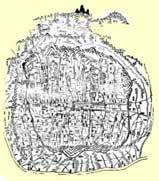한국어 번역 - 클릭
 |
| Bukchon |
Bukchon's location, adjacent to and between, the Gyeongbokgung (Gyeongbok Palace) and Changdeokgung (Changdeok Palace or Palace of Prospering Virtue) gave both the district and its residents a role to play throughout the history of the Chosun Dynasty (1392-1910) (also, Choson, Chosŏn, Joseon).
Assassination and murder were a recurrent part of political life and dynastic succession throughout the Chosun Dynasty, as in many other feudal kingdoms. Take the story of King Tanjong, for example.
King Tanjong assumed the throne at the age of 12 in 1452. However, his uncle, the ambitious Prince Suyang (Suyang Daegun), was not content with that state of affairs. The following year, 1453, Prince Suyang arranged for the King's retainers and ministers to be ambushed as they traveled through Bukchon. The attack took place in a district just south of today's Kahoi-Dong and a little north of Anguk.
The number of people killed was not recorded but was apparently a very large number. The land was so drenched in blood that wood fires had to be lit across the killing fields to quench the smell of death and purify the land. The ash left from the fires led to the district being named "the valley of ashes" or "the road of ashes," Jae-gol, today's Jae-Dong.
Prince Suyang ascended the throne and became King Sejo. The next year, King Sejo killed all people considered loyal to Tanjong, including six ministers and philosophers who were accused of planning to assassinate King Sejo and restore Tanjong to the throne. Many, perhaps most, of these deaths also occurred in Bukchon. The six came to be known as the "Six Martyred Ministers." Plotting against, even being suspected of plotting against, a king was a capital crime which generally led to the deaths of the families and relations of those accused. Former King Tanjong was later reduced in rank to a commoner and forced to commit suicide.
As the centuries passed, Bukchon became established as home to the Yangban, the scholar-aristocrats involved with the Royal court. Murder and intrigue were a normal part of life and so there were many killings, but none perhaps as massive as that of 1453.
These tragic events present many opportunities for unquiet spirits
to wander the land. According to local legends, other parts of the Bukchon
are also associated with violent deaths over the centuries
that followed. It seems pretty clear that there has been ample opportunity
for whole legions of unquiet spirits to have been left to wander the
land. These sad details are not widely promulgated by real estate developers
and agents.
Not surprisingly, unquiet spirits from such incidents are supposed to
continue to haunt particular plots of land. According to local lore,
there are places where the residents are fated to be consumed by quarrels
and family strife.
Not far from our own house is a plot where men are particularly prone
to fatal heart attacks as they try to enter.
Another neighboring plot is associated with madness and suicide.
What credibility should be attached to these tales? Do they simply reflect the vestigial memories of terrible historical events? Or are there ghosts that wander among the living of Bukchon?
David Kilburn
Korean Page here
![]()